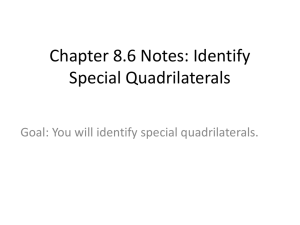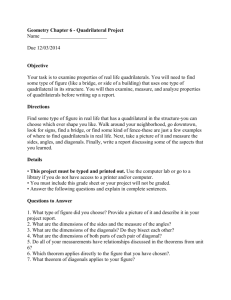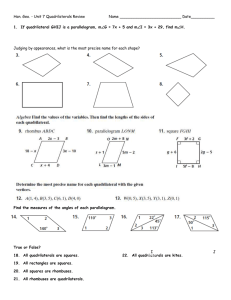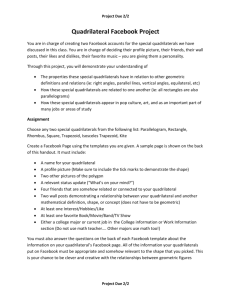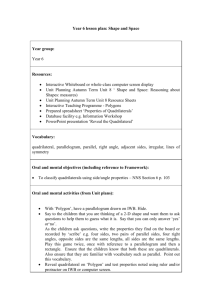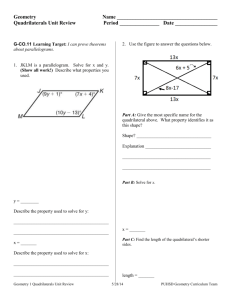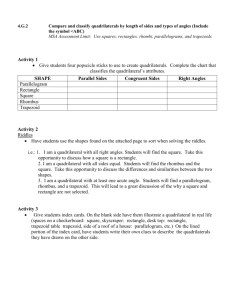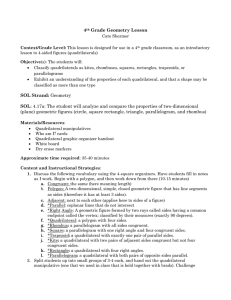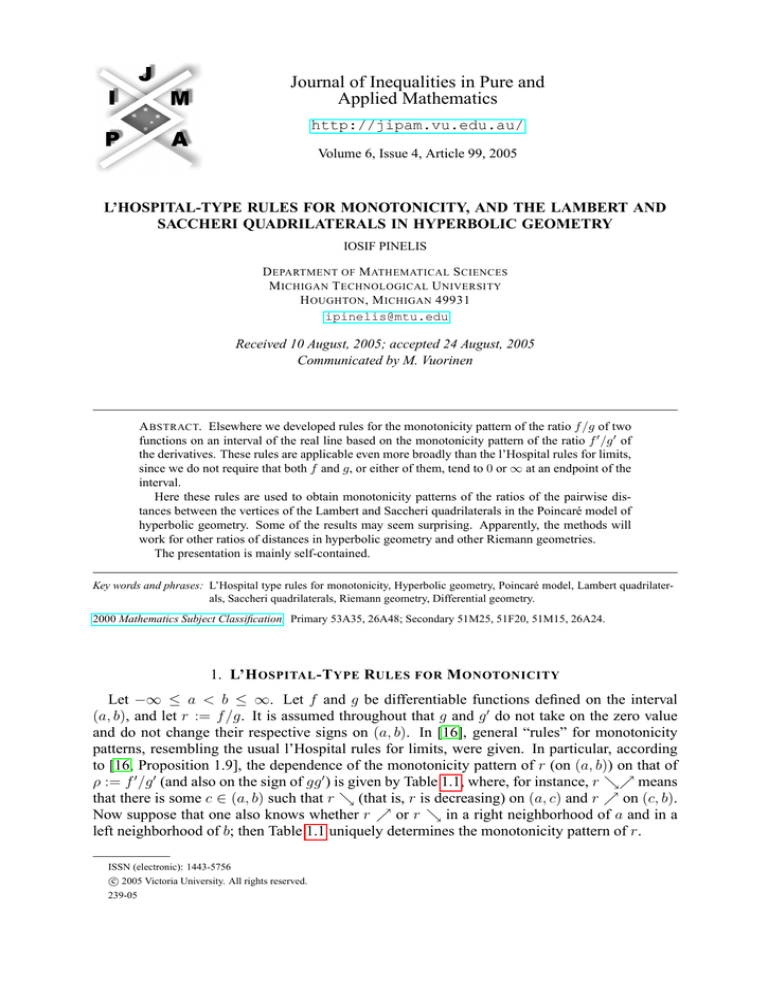
Journal of Inequalities in Pure and
Applied Mathematics
http://jipam.vu.edu.au/
Volume 6, Issue 4, Article 99, 2005
L’HOSPITAL-TYPE RULES FOR MONOTONICITY, AND THE LAMBERT AND
SACCHERI QUADRILATERALS IN HYPERBOLIC GEOMETRY
IOSIF PINELIS
D EPARTMENT OF M ATHEMATICAL S CIENCES
M ICHIGAN T ECHNOLOGICAL U NIVERSITY
H OUGHTON , M ICHIGAN 49931
ipinelis@mtu.edu
Received 10 August, 2005; accepted 24 August, 2005
Communicated by M. Vuorinen
A BSTRACT. Elsewhere we developed rules for the monotonicity pattern of the ratio f /g of two
functions on an interval of the real line based on the monotonicity pattern of the ratio f 0 /g 0 of
the derivatives. These rules are applicable even more broadly than the l’Hospital rules for limits,
since we do not require that both f and g, or either of them, tend to 0 or ∞ at an endpoint of the
interval.
Here these rules are used to obtain monotonicity patterns of the ratios of the pairwise distances between the vertices of the Lambert and Saccheri quadrilaterals in the Poincaré model of
hyperbolic geometry. Some of the results may seem surprising. Apparently, the methods will
work for other ratios of distances in hyperbolic geometry and other Riemann geometries.
The presentation is mainly self-contained.
Key words and phrases: L’Hospital type rules for monotonicity, Hyperbolic geometry, Poincaré model, Lambert quadrilaterals, Saccheri quadrilaterals, Riemann geometry, Differential geometry.
2000 Mathematics Subject Classification. Primary 53A35, 26A48; Secondary 51M25, 51F20, 51M15, 26A24.
1. L’H OSPITAL -T YPE RULES FOR M ONOTONICITY
Let −∞ ≤ a < b ≤ ∞. Let f and g be differentiable functions defined on the interval
(a, b), and let r := f /g. It is assumed throughout that g and g 0 do not take on the zero value
and do not change their respective signs on (a, b). In [16], general “rules” for monotonicity
patterns, resembling the usual l’Hospital rules for limits, were given. In particular, according
to [16, Proposition 1.9], the dependence of the monotonicity pattern of r (on (a, b)) on that of
ρ := f 0 /g 0 (and also on the sign of gg 0 ) is given by Table 1.1, where, for instance, r &% means
that there is some c ∈ (a, b) such that r & (that is, r is decreasing) on (a, c) and r % on (c, b).
Now suppose that one also knows whether r % or r & in a right neighborhood of a and in a
left neighborhood of b; then Table 1.1 uniquely determines the monotonicity pattern of r.
ISSN (electronic): 1443-5756
c 2005 Victoria University. All rights reserved.
239-05
2
I OSIF P INELIS
ρ
gg 0
r
%
&
%
&
>0
>0
<0
<0
% or & or &%
% or & or %&
% or & or %&
% or & or &%
Table 1.1: Basic rules for monotonicity
Clearly, these l’Hospital-type rules for monotonicity patterns are helpful wherever the l’Hospital
rules for limits are so, and even beyond that, because the monotonicity rules do not require that
both f and g (or either of them) tend to 0 or ∞ at any point.
The proof of these rules is very easy if one additionally assumes that the derivatives f 0 and
g 0 are continuous and r0 has only finitely many roots in (a, b) (which will be the case if, for
instance, r is not a constant and f and g are real-analytic functions on [a, b]): Indeed, suppose
that the assumptions ρ % and gg 0 > 0 of the first line of Table 1.1 hold. Then it suffices to
show that r0 (x) may change sign only from − to + as x increases from a to b. To obtain a
contradiction, suppose the contrary, so that there is some root u of r0 in (a, b) such that in some
right neighborhood (u, t) of the root u one has r0 < 0 and hence r < r(u). Consider now the
key identity
g 2 r0 = (ρ − r) g g 0 ,
(1.1)
which is easy to check. Then the conditions r0 (u) = 0 and r0 < 0 on (u, t) imply, respectively,
that ρ(u) = r(u) and ρ < r on (u, t). It follows that ρ < r < r(u) = ρ(u) on (u, t), which
contradicts the condition ρ %. The other three lines of Table 1.1 can be treated similarly. A
proof without using the additional conditions (that the derivatives f 0 and g 0 are continuous and
r0 has only finitely many roots) was given in [16].
Based on Table 1.1, one can generally infer the monotonicity pattern of r given that of ρ,
however complicated the latter is. In particular, one has Table 1.2.
ρ
gg 0
r
%&
&%
%&
&%
>0
>0
<0
<0
% or & or %& or &% or &%&
% or & or %& or &% or %&%
% or & or %& or &% or %&%
% or & or %& or &% or &%&
Table 1.2: Derived rules for monotonicity
In the special case when both f and g vanish at an endpoint of the interval (a, b), l’Hospitaltype rules for monotonicity and their applications can be found, in different forms and with
different proofs, in [9, 11, 14, 8, 2, 3, 1, 4, 5, 15, 16, 17, 18].
The special-case rule can be stated as follows: Suppose that f (a+) = g(a+) = 0 or f (b−) =
g(b−) = 0; suppose also that ρ is increasing or decreasing on the entire interval (a, b); then,
respectively, r is increasing or decreasing on (a, b). When the condition f (a+) = g(a+) = 0
or f (b−) = g(b−) = 0 does hold, the special-case rule may be more convenient, because then
J. Inequal. Pure and Appl. Math., 6(4) Art. 99, 2005
http://jipam.vu.edu.au/
L AMBERT ’ S AND S ACCHERI ’ S Q UADRILATERALS
3
one does not have to investigate the monotonicity pattern of ratio r near the endpoints of the
interval (a, b).
The special-case rule is easy to prove. For instance, suppose that f (a+) = g(a+) = 0. Then
g and g 0 must have the same sign on (a, b). By the mean-value theorem, for every x ∈ (a, b)
there is some ξ ∈ (a, x) such that r(x) = ρ(ξ). Now the rule follows by identity (1.1).
This latter proof is essentially borrowed from [2, Lemma 2.2]. Another very simple proof of
the special-case rule was given in [15]; that proof remains valid under somewhat more general
conditions on f and g. A unified treatment of the monotonicity rules, applicable whether or not
f and g vanish at an endpoint of (a, b), can be found in [16].
(L’Hospital’s rule for the limit r(b−) (say) when g(b−) = ∞ does not have a “specialcase” analogue for monotonicity, even if one also has f (b−) = ∞. For example, consider
f (x) = x − 1 − e−x and g(x) = x for x > 0. Then r % on (0, ∞), even though ρ & on (0, ∞)
and f (∞−) = g(∞−) = ∞.)
In view of what has been said here, it should not be surprising that a very wide variety of
applications of these l’Hospital-type rules for monotonicity patterns were given: in areas of
analytic inequalities [15, 16, 19, 5], approximation theory [17], differential geometry [8, 9, 11],
information theory [15, 16], (quasi)conformal mappings [1, 2, 3, 4], statistics and probability
[14, 16, 17, 18], etc.
Clearly, the stated rules for monotonicity could be helpful when f 0 or g 0 can be expressed simpler than f or g, respectively. Such functions f and g are essentially the same
as the functions
R
R
that could be taken to play the role of u in the integration-by-parts formula u dv = uv− v du;
this class of functions includes polynomial, logarithmic, inverse trigonometric and inverse
hyperbolic
R x functions, and
R bas well as non-elementary “anti-derivative” functions of the form
x 7→ a h(u) du or x 7→ x h(u) du.
(“Discrete” analogues, for f and g defined on Z, of the l’Hospital-type rules for monotonicity,
are available as well [20].)
In the present paper, we use the stated rules for monotonicity to obtain monotonicity properties of the Lambert and Saccheri quadrilaterals in hyperbolic geometry. This case represents
a perfect match between the two areas. Indeed, the distances in hyperbolic geometry are expressed in terms of inverse hyperbolic functions, whose derivatives are algebraic. One can
expect these rules to work for other Riemann geometries as well, since the geodesic distances
there are line integrals, too.
2. M ONOTONICITY P ROPERTIES OF THE L AMBERT
Q UADRILATERALS
AND
S ACCHERI
2.1. Background.
2.1.1. Hyperbolic plane. The Lambert and Saccheri quadrilaterals are quadrilaterals in the
Poincaré hyperbolic plane H 2 .
The significance of the Poincaré model is that, by the Riemann mapping theorem, any simply
connected analytic Riemann surface is conformally equivalent to H 2 , C, or C ∪ {∞} [7, Theorem 9.1]. Moreover, any analytic Riemann surface is conformally equivalent to the quotient
surface R̃/G, where R̃ is H 2 , C, or C ∪ {∞}, and G is a group of Möbius transformations acting discontinuously on (the covering surface) R̃ [7, Proposition 9.2.3]. However, this comment
will not be used further in this paper.
To make this section mainly self-contained, let us fix the terminology and basic facts concerning the Poincaré model of hyperbolic plane geometry. The set of points in this model is the
upper half-plane
H 2 := {z ∈ C : Im z > 0}.
J. Inequal. Pure and Appl. Math., 6(4) Art. 99, 2005
http://jipam.vu.edu.au/
4
I OSIF P INELIS
This set is endowed with the differential metric element
|dz|
ds :=
,
Im z
so that the length of any rectifiable curve in H 2 is obtained as the line integral of ds. For x ∈ R
and r ∈ R \ {0}, let us refer to the semicircles
[[x − r, x + r]] := {z ∈ H 2 : |z − x| = |r|},
centered at point x and of radius |r|, and the vertical rays
[[x, ∞]] := {z ∈ H 2 : Re z = x}
as the “lines”. It will be seen in a moment that these “lines” are precisely the geodesics in this
geometry, so that the geodesics are orthogonal to the real axis.
For x ∈ R and r ∈ R \ {0}, let ιx,r denote the reflection of H 2 in the semicircle [[x − r, x + r]],
so that, for z ∈ H 2 ,
r2
.
ιx,r (z) := x +
z−x
It is easy to see that this transformation is inverse to itself and preserves H 2 as well as the
metric element ds, and hence also the (absolute value of the) angles. Indeed, if w := ιx,r (z)
for z ∈ H 2 , then Im w = r2 Im z/|z − x|2 and dw = −r2 dz/(z − x)2 , so that Im w > 0 and
|dw|/ Im w = |dz|/ Im z.
Let G be the group of transformations of H 2 generated by all such reflections. Then G
preserves the metric element ds. Note that G contains all the homotheties z 7→ ηx,λ (z) :=
x + λ(z − x), horizontal parallel translations z 7→ σx (z) := z + x, and reflections z 7→
ιx,∞ (z) := 2x−z in the vertical rays [[x, ∞]], where x ∈ R and λ > 0; indeed, ηx,λ = ιx,√λ ◦ιx,1 ,
ιx,∞ = ιx+r,2r ◦ ιx−r,2r ◦ ιx+r,2r , and σx = ιx/2,∞ ◦ ι0,∞ .
It is easy to see that the geodesic connecting two points z1 and z2 on the same vertical ray
[[x, ∞]] (x ∈ R) is the segment of that ray with the endpoints z1 and z2 , so that the geodesic
distance d(z1 , z2 ) between such z1 and z2 is | ln(y1 /y2 )|, where yj := Im zj , j = 1, 2. Now
it is seen that group G acts transitively on the set of all ordered pairs (z1 , z2 ) of points on the
vertical ray [[x, ∞]] with a fixed value of the distance d(z1 , z2 ) — in the sense that, for any
two pairs (z1 , z2 ) and (w1 , w2 ) of points on [[x, ∞]] with d(z1 , z2 ) = d(w1 , w2 ), there is some
transformation g in G such that g(zj ) = wj , j = 1, 2; indeed, it suffices to take g to be a single
reflection ιx,r or a single homothety ηx,λ , for some r > 0 or λ > 0.
Next, the reflection ιx+r,2r maps the semicircle [[x − r, x + r]] onto the vertical ray [[x − r, ∞]],
and hence vice versa, for all x ∈ R and r ∈ R \ {0}. Moreover, any two distinct points in H 2
lie on exactly one “line”.
It follows now that indeed the “lines” are precisely the geodesics, and group G acts transitively on the set of all ordered pairs (z1 , z2 ) of points in H 2 with any fixed value of the geodesic
distance d(z1 , z2 ). Another corollary here is the formula for the geodesic distance between any
two points z1 and z2 of H 2 :
|z1 − z2 |2
(2.1)
d(z1 , z2 ) = arcch 1 +
,
2 Im z1 Im z2
√
where arcch x := ln x + x2 − 1 for x > 1; cf. [6, Theorem 7.2.1(ii)]. One can now also
easily derive Pythagoras’ theorem,
(2.2)
ch c = ch a ch b,
for a right-angled (geodesic) triangle ABC with side c opposite to the right-angle vertex C
and two other sides a and b; indeed, such a triangle is G-congruent, for some k ∈ (0, 1) and
J. Inequal. Pure and Appl. Math., 6(4) Art. 99, 2005
http://jipam.vu.edu.au/
L AMBERT ’ S AND S ACCHERI ’ S Q UADRILATERALS
5
LAMBERT’S AND SACCHERI’S QUADRILATERALS
5
iθ
θ ∈ (0, π/2), to the triangle with vertices C∗ = i, A∗ = k i, and B∗ = e ; cf. [6, Theorem
7.11.1]. (Yet another corollary, not to be used in this paper, is that G is the group of all isometries
of H 2 .)
2.1.2. Lambert’s and Saccheri’s quadrilaterals. A Lambert quadrilateral is a quadrilateral
Lambert’s
and Saccheri’s
quadrilaterals.
A Lambert
quadrilateral
is asome
quadrilateral
in
in the 2.1.2.
Poincaré
hyperbolic
plane with
angles π/2,
π/2, π/2,
and ϕ, for
ϕ; a Saccheri
the Poincaré
plane with
π/2,
π/2, π/2, and
ϕ, forwith
someangles
ϕ; a Saccheri
quadriquadrilateral
is ahyperbolic
quadrilateral
(alsoangles
in the
hyperbolic
plane)
π/2, π/2,
ψ and
lateral is a quadrilateral (also in the hyperbolic plane) with angles π/2, π/2, ψ and ψ, for some
ψ, for some ψ [6, Section 7.17]. See Figure 2.1.
ψ [6, Section 7.17]. See Figure 2.1.
For a For
Saccheri
quadrilateral,
usrefer
refertoto
(the
length
side adjacent
the right
a Saccheri
quadrilateral,let
let us
(the
length
of) itsof)
sideits
adjacent
to the righttoangles
anglesasasthethe
base,
its opposite
as and
the totop,
and
of (congruent
the othertotwo
base,
its opposite
side asside
the top,
either
of to
the either
other two
each(congruent
other)
to each
other)
sides
simply
sides
simply
as the
side. as the side.
A Lambert
quadrilateralhas
has two
adjacent
to twotooftwo
the three
right
angles.
Let angles.
us
A Lambert
quadrilateral
twosides
sideseach
each
adjacent
of the
three
right
arbitrarily
choose
one
of
these
two
sides
and
refer
to
it
as
the
base,
and
to
the
other
one
of
the
Let us arbitrarily choose one of these two sides and refer to it as the base, and to the other
the (short)
The side
to theopposite
base will again
referred
as the top,
and
one oftwo
theastwo
as theside.
(short)
side.opposite
The side
to thebe base
willto again
be referred
the
fourth
side
as
the
long
side.
It
will
be
seen
in
the
next
subsection
that
indeed
the
long
side
to as the top, and the fourth side as the long side. It will be seen in the next subsection
is always longer than the short one.
that indeed the long side is always longer than the short one.
DL
AL
DS
AS
B
C
Figure 2.1: Lambert’s (AL BCDL ) and Saccheri’s (AS BCDS ) quadrilaterals; AL B, AL DL , BC, and
Figure
2.1: Lambert’s
(AL BCD
Saccheri’s
(AS BCD
AL B,
AL DL , BC, and
are
L ) and
S ) quadrilaterals;
respectively
the base,
short
side,
long side,
and top
of the Lambert
quadrilateral;
ASCD
B,LA
CDL are
S DS =
respectively
the
base,
short
side,
long
side,
and
top
of
the
Lambert
quadrilateral;
A
B,
A
D
=
BC,
and
CD
S
S
S
S
BC, and CDS are respectively the base, side, and top of the Saccheri quadrilateral; the angles at vertices
are respectively the base, side, and top of the Saccheri quadrilateral; the angles at vertices AS , B, AL , and DL
ALπ/2.
, and DL are π/2.
AS , B,are
It follows from the discussion in Subsubsection 2.1.1 that the group G acts transitively on the
It follows
the quadrilaterals
discussion in
Subsubsection
the the
group
transitively
set of allfrom
Saccheri
with
any given values2.1.1
of thethat
base and
side, G
as acts
well as
on the
on thesetset
Saccheri
quadrilaterals
given
ofthe
theshort
base
and
the
of of
all all
Lambert
quadrilaterals
with anywith
given any
values
of thevalues
base and
side.
That
is,side,
all as
well asSaccheri
on thequadrilaterals
set of all Lambert
with
of the base
and the
with any quadrilaterals
given values of the
baseany
and given
the sidevalues
are G-congruent
to each
so,is,
they
the same
geodesic distances
any two
of their
corresponding
short other,
side. and
That
allhave
Saccheri
quadrilaterals
withbetween
any given
values
of the
base and the
vertices.
The sametoholds
all Lambert
quadrilaterals
any given
values distances
of the base between
and
side are
G-congruent
eachfor
other,
and so,
they have with
the same
geodesic
the
short
side.
any two of their corresponding vertices. The same holds for all Lambert quadrilaterals
with any
values of the base and the short side.
2.2. given
Main Results.
2.2.1. Lambert quadrilaterals. In view of the conclusions of Subsection 2.1, any Lambert
quadrilateral
is G-congruent, for some
2.2. Main
results.
k ∈ (0, 1) and θ ∈ (0, π/2),
2.2.1. Lambert quadrilaterals. In view of the conclusions of Subsection 2.1, any Lambert
quadrilateral is G-congruent, for some
J. Inequal. Pure and Appl. Math., 6(4) Art. 99, 2005
k ∈ (0, 1) and θ ∈ (0, π/2),
http://jipam.vu.edu.au/
6
(see Figure
2.2), so that, by (2.1),
(2.3)
(2.4)
I OSIF P INELIS
1 + k2
1
, ,
AB = ln , BC = arcch c, CD = arcch
q
to the particular Lambert k
quadrilateral ABCD with vertices
2
(1, +where
k 2 ) ψ := arccos ch(ln
c (1
A = k i, B =2i,c k C = eiθ , D = k ceiψ
k) +
coskθ )
AD = arcch
, AC = arcch
, BD = arcch
,
q
2
k
q
(see Figure 2.2), so that, by (2.1),
1 + k2
1 + k 2 )2 − c2 (1 − k 2 )2
where AB
q :=
= ln (1
, BC = arcch c, CD = arcchand c, :=
, 1/ sin θ.
k
q
(2.3)
(One can
verify, using (2.2)
2 c kand (2.3), that
c (1indeed
+ k 2 ) ∠A = ∠B c=(1 ∠C
+ k 2 )= π/2.) Then one
AD
=
arcch
,
AC
=
arcch
,
BD
=
arcch
,
may refer to AB as the base,
q of length ln(1/k),
2 k and to BC as the
q short side, of length
p D to exist in H 2 , one must have ch(ln k) cos θ < 1, which
arcch c. (2.4)
Note that, for
the qpoint
where
:= (1
+ k 2 )2 − c2 (1 − k 2 )2 and c := 1/ sin θ.
is equivalent to
(One can verify, using (2.2) and (2.3), that indeed ∠A = ∠B = ∠C2 = π/2.) Then one may
1 + k of length arcch c. Note
refer to AB as the base, of1length
ln(1/k),
to BC as
where
ck the
:=short side,
.
< c 2<
ck , and
that, for the point D to exist in H , one must have ch(ln k) cos 1θ <
− 1,k 2which is equivalent to
2 is fixed) and let c increase from
Let us fix (the length of) the base AB (so that k ∈1(0,
+ k1)
1 < c < ck , where ck :=
.
2
1
−
k
from
0 to arcch ck . The goal here
1 to ck , so that the short side BC = arcch c increases
6 ∈ (0, 1) is fixed) and let c increase from
Let
us
fix
(the
length
of)
the
base
AB
(so
that
k
representative pairwise
is to determine the monotonicity patterns of 2 = 15
4completely
1 to ck , so that the short side BC = arcch c increases from
0 to arcch ck . The goal here is
6 (geodesic)
distances between
ratios r to=determine
CD/AD,
CD/BD, . . . , BC/AB of the 2 =representative
the monotonicity patterns of 62 = 15 completely
pairwise ratios
the fourrvertices
A, B,
C, D.. . .For
each pair
distances,
it is enough
to consider
only
= CD/AD,
CD/BD,
, BC/AB
of the of42 such
= 6 (geodesic)
distances
between the
four
one of the
twoA,mutually
reciprocal
indeed,
for example,
vertices
B, C, D. For
each pair of ratios;
such distances,
it is enough
to considerthe
onlymonotonicity
one of the two pattern
mutually
reciprocal
ratios;
indeed,
for
example,
the
monotonicity
pattern
of
the
ratio
of the ratio CD/AD determines that of AD/CD. All the ratios r willCD/AD
be expressed as
determines
that
of
AD/CD.
All
the
ratios
r
will
be
expressed
as
functions
of
c.
(We
functions of c. (We do not distinguish in terminology or notation betweendoanotsegment of
distinguish in terminology or notation between a segment of a geodesic and its length.)
geodesics and its length.)
A
shor
ts
ide
diagonal C
t
or
sh
top
base
B
long
sid
e
D
Figure 2.2: A Lambert quadrilateral: ∠A = ∠B = ∠C = π/2
Figure 2.2: A Lambert quadrilateral: ∠A = ∠B = ∠C = π/2
Theorem
monotonicity
patterns
of theof
15 the
representative
ratios r(c) areratios
given by
Ta- are given
Theorem
2.1. 2.1.
TheThemonotonicity
patterns
15 representative
r(c)
√ √
2.1, where k∗ := 2 − 1.
by Tableble2.1,
where k∗ := 2 − 1.
One simple corollary here is that, of the two sides (BC and AD) of the Lambert
J. Inequal. Pure and Appl. Math., 6(4) Art. 99, 2005
http://jipam.vu.edu.au/
quadrilateral, BC is indeed always the shorter one (this is obvious from Figure 2.2 as
well). Also, of the two diagonals (AC and BD) of the quadrilateral, AC is always the
L AMBERT ’ S AND S ACCHERI ’ S Q UADRILATERALS
Pattern for each k in
r
r(1+) r(ck −)
7
Comments
(0, 1) (0, k∗ ] (k∗ , 1)
%
&
CD/AC
CD/AD
&%
&%
1
∞
∞
1
CD/BC
&%
∞
∞
CD/BD
CD/AB
&%
%
1
1
1
∞
AC/AD
AC/BC
AC/BD
AC/AB
&
&
&
%
∞
∞
1
1
0
>1
0
>1
BD/AD
&
∞
1
BD/BC
&%
∞
∞
BD/AB
%
1
∞
AD/BC
AD/AB
%
%
>1
0
∞
∞
BC/AB
%
0
∃c ∈ (1, ck ) r(c) = 1
√
⇐⇒ k > 1/ 3
∀k ∈ (0, 1) ∀c ∈ (1, ck )
r(c) > 1
r(ck −) r(ck −) > 1 ⇐⇒ k > k∗
Table 2.1: Monotonicity patterns for the ratios in the Lambert quadrilateral
One simple corollary here is that, of the two sides (BC and AD) of the Lambert quadrilateral,
BC is indeed always the shorter one (this is obvious from Figure 2.2 as well). Also, of the two
diagonals (AC and BD) of the quadrilateral, AC is always the shorter one.
What is perhaps surprising is that the monotonicity patterns of two ratios, CD/AC (topto-short-diagonal) and CD/AD (top-to-long-side), turn out to depend on (the fixed length of)
the base√AB = ln(1/k) of the quadrilateral. When the base AB is smaller than ln(1/k∗ ) =
ln(1 + 2), these two ratios are not monotonic.
Three other ratios — CD/BC (top-to-short-side), CD/BD (top-to-long-diagonal), and
BD/BC (long-diagonal-to-short-side) — are not monotonic for any given base; however, this
should not be surprising, since for each of these three ratios r one has r(1+) = r(ck −).
In particular, it follows that of all the 5 ratios of the top to the other lengths, only the trivial
one, the ratio CD/AB of the top to the fixed base, is monotonic for every given base.
Another small-base peculiarity shows up for two ratios, CD/BC (top-to-short-side) and
BC/AB (short-side-to-base); namely,
√ these ratios take on values to both sides of 1 iff the base
is small√enough – smaller than ln 3 in the case of CD/BC and smaller than ln(1/k∗ ) =
ln(1 + 2) in the case of BC/AB.
Proof of Theorem 2.1. From (2.3), it is clear that the 5 ratios of BC, CD, AD, AC, and BD
to the fixed AB are increasing (in c), and the inequality BC/AB > 1 can be rewritten as
ch BC > ch AB, which is equivalent to k > k∗ . The monotonicity pattern for AC/AD =
J. Inequal. Pure and Appl. Math., 6(4) Art. 99, 2005
http://jipam.vu.edu.au/
8
I OSIF P INELIS
(AC/BD)(BD/AD) obviously follows from those for AC/BD and BD/AD. It remains to
consider the other 9 of the 15 ratios.
In terms of the expression q, defined by (2.4), and the expressions
p
√
(2.5)
q1 := (c2 − 1)(1 + k 2 )2 + (1 − k 2 )2 , q2 := c2 − 1,
p
(2.6)
q3 := 2(c2 − 1)(1 + k 4 ) + (1 − k 2 )2 ,
one computes the ratios, ρ, of the derivatives of the distances with respect to c:
(CD)0
(1 − k 2 ) q1
=
,
(AC)0
q2
(CD)0
(1 − k 2 ) q2
=
,
(AD)0
2k
(CD)0
(1 − k 2 ) q3
=
,
(BD)0
(1 + k 2 )2
(1 + k 2 ) q2
(AC)0
=
,
(BC)0
q1
(AC)0
q 2 q3
=
,
(BD)0
(1 + k 2 )2 q1
(BD)0
(1 + k 2 )2 q2
=
,
(AD)0
2 k q3
2 k (1 + k 2 )
(AD)0
=
,
(BC)0
q2
(CD)0
(CD)0 (AC)0
=
,
(BC)0
(AC)0 (BC)0
(BD)0
(BD)0 (AD)0
=
.
(BC)0
(AD)0 (BC)0
Of these 9 ratios, it is now clear that 8 ratios (except (AC)0 /(BD)0 ) are increasing (in
c). Hence, by the first line of Table 1.1, each of the corresponding 8 ratios, r, of distances,
CD/AC, . . . , AD/BC (except for AC/BD), has one of these three patterns: %, &, or &%.
(It can be shown that (AC)0 /(BD)0 is & or %&, depending on whether the base, AB, is large
enough; however, this fact will not be used in this paper.)
Now let us consider each of the 8 “unexceptional” ratios separately, after which the “exceptional” ratio, AC/BD, will be considered.
(1) r(c) = CD/AC: Here it is obvious that r(1+) = 1 and r(ck −) = ∞. This excludes
the pattern r &. To discriminate between the possibilities r & and r &%, it suffices
to determine whether there exists some c ∈ (1, ck ) such that r(c) = 1 or, equivalently,
ch CD = ch AC. Now it is easy to complete the proof of Theorem 2.1 for the ratio
r(c) = CD/AC.
(2) r(c) = CD/AD: Here it is obvious that r(1+) = ∞. By l’Hospital’s rule for limits,
r(ck −) = ρ(ck −) = 1. This excludes the pattern r %. Moreover, it is easy to see, as in
the previous case, that there exists some c ∈ (1, ck ) such that r(c) = 1 iff k > k∗ .
(3) r(c) = CD/BC: Here r(1+) = r(ck −) = ∞. Hence, r &%. Moreover,
it is easy to
√
see that there exists some c ∈ (1, ck ) such that r(c) = 1 iff k > 1/ 3.
(4) r(c) = CD/BD: Here r(1+) = 1. By l’Hospital’s rule for limits, r(ck −) = ρ(ck −) =
1. Hence, r &%.
√
(5) r(c) = AC/BC: Here, with µ := 2k (1 + k 2 ) and ν := 1 + 14k 4 + k 8 , one has the
following at c = ck − :
r0 ·
2k ν BC 2
BC
=µ
− ν < µ − ν,
2
(1 − k )AC
AC
since, in view of (2.3), BC < AC. But µ2 − ν 2 = −(1 − k 2 )4 < 0. Hence, r0 (ck −) < 0,
so that r & in a left neighborhood of ck . Thus, r &.
(6) r(c) = BD/AD: Here r(1+) = ∞. By l’Hospital’s rule for limits, r(ck −) =
ρ(ck −) = 1. In view of (2.3), here r > 1 on (1, ck ). Hence, r is decreasing on (1, ck )
from ∞ to 1.
(7) r(c) = BD/BC: Here r(1+) = r(ck −) = ∞. Hence, r &% on (1, ck ). Also, in
view of (2.3), one has here r > 1 on (1, ck ).
(8) r(c) = AD/BC: Here, by the special-case rule for monotonicity, r %. By l’Hospital’s
rule, r(1+) = ρ(1+) = (1 + k 2 )/(2k) > 1. Also, it is obvious that r(ck −) = ∞.
J. Inequal. Pure and Appl. Math., 6(4) Art. 99, 2005
http://jipam.vu.edu.au/
L AMBERT ’ S AND S ACCHERI ’ S Q UADRILATERALS
9
It remains to consider the 9th ratio,
¶ r(c) = AC/BD: Here, as was stated, ρ(c) := (AC)0 /(BD)0 is non-monotonic in c for
k in a left neighborhhood of 1. This makes it more difficult to act as in the cases considered
above, since the root c of the equation ρ0 (c) = 0 depends on k. However, what helps here is that
the monotonicity pattern of r turns out to be simple, as will be proved in a moment: r &. One
can use the following lemma, whose proof is based on the special-case rule for monotonicity
stated in Section 1.
Lemma 2.2. For x > 1, let
√
x2 − 1 arcch x
λ(x) :=
,
x3
Then for all u and v in (1, ∞)
√
x2 − 1
α(x) :=
,
x3
λ(v)
6 max
λ(u)
α(v) β(v)
,
α(u) β(u)
Proof of Lemma 2.2. Obviously, λ/β = arcch %. Hence,
to consider the case when 1 < u < v. Note that
(arcch x)0
1
√
0 =
x
x2 − 1
β(x) :=
x2 − 1
.
x3
.
λ(v)
λ(u)
6
β(v)
β(u)
if 1 < v 6 u. It remains
is decreasing in x > 1. Hence, by the special-case rule for monotonicity,
arcch x
λ(x)
=√
α(x)
x2 − 1
is decreasing in x > 1. Hence,
λ(v)
λ(u)
<
α(v)
α(u)
if 1 < u < v.
Let us now return to the consideration of the ratio r(c) = AC/BD. It suffices to show that
r0 (c) < 0 for all k ∈ (0, 1) and c ∈ (1, ck ). One has the identity
√
√
2 BD2 k u2 − 1 v 2 − 1
λ(v)
0
r (c)
=
− K,
(1 + k 2 ) λ(u) v 3
λ(u)
where
c (1 + k 2 )
u :=
,
2k
v := q
c (1 + k 2 )
(1 +
k 2 )2
−
c2
(1 −
,
k 2 )2
K :=
1 + k2
2k
2
.
Therefore and in view of Lemma 2.2, it suffices to show that the expressions
!
2
6 2
2 6
α(v)
2 4 c k (1 + k )
2
P :=
−K
α(u)
and
α(u)
(1 − k 2 )2
!
2
6
2 6
β(v)
2 c (1 + k )
2
Q :=
−K
β(u)
β(u)
(1 − k 2 )2
are negative for all k ∈ (0, 1) and c ∈ (1, ck ). But this can be done in a completely algorithmic
manner, since P and Q are polynomials in k and c, and ck is a rational function of k [21, 12, 10].
With Mathematica, one can use the command Reduce[P>=0 && 1<c<ck && 0<k<1]
(where ck stands for ck ), which outputs False, meaning that indeed P < 0 for all k ∈ (0, 1)
and c ∈ (1, ck ); similarly, for Q in place of P .
Theorem 2.1 is proved.
J. Inequal. Pure and Appl. Math., 6(4) Art. 99, 2005
http://jipam.vu.edu.au/
LAMBERT’S AND SACCHERI’S QUADRILATERALS
10
I OSIF P INELIS
2.2.2. Saccheri quadrilaterals. Let ABCD be a Saccheri quadrilateral. Here one m
assume 2.2.2.
that Saccheri quadrilaterals. Let ABCD be a Saccheri quadrilateral. Here one may assume
that
= k eiθ ,
A = k i, B = i, Ciθ= eiθ , D
iθ
A = k i, B = i, C = e , D = k e ,
where again 0 < k < 1 and 0 < θ < π/2, so that the angles at vertices A and B are rig
where again 0 < k < 1 and 0 < θ < π/2, so that the angles at vertices A and B are right,
and BCand
= BC
AD,
BD
Letusus
refer
AB =asln(1/k)
as the
= so
AD,that
so that
BD=
= AC.
AC. Let
refer
here here
to AB to
= ln(1/k)
the base and
to base and
BC = AD
=AD
arcch
c as
the
where
:=θ. 1/
θ. Here
from 1 to ∞.
BC =
= arcch
c as
the side,
side, where
againagain
c := 1/csin
Heresin
c varies
from 1c tovaries
∞.
B
base
sid
e
A
sid
e
D
top
C
Figure 2.3: A Saccheri quadrilateral: ∠A = ∠B = π/2 and ∠C = ∠D, whence AD = BC and AC =
Figure 2.3: A Saccheri quadrilateral: ∠A = ∠B = π/2 and ∠C = ∠D, whence AD = BC and AC = BD
Again, Again,
let usletfix
the
AB= =
ln(1/k)
∈ (0,also,
1) isletfixed);
us fix
thebase
base AB
ln(1/k)
(so that(so
k ∈that
(0, 1) k
is fixed);
c increasealso,
from let c incre
1 to∞,
∞, so
so that
thethe
side side
BC =BC
AD =
increases
0 to ∞. Here,
taking
into∞.
account
from 1 to
that
=arcch
ADc=
arcchfrom
c increases
from
0 to
Here, taking i
the equalities BC = AD and BD = AC, we have to determine the monotonicity patterns of
account 4the
equalities
BC = AD and BD = AC, we have to determine the monotonic
= 64completely
representative pairwise ratios.
2
patterns of 2 = 6 completely representative pairwise ratios.
Theorem 2.3. The monotonicity patterns of the 6 ratios r(c) are given by Table 2.2.
Theorem 2.3. The monotonicity patterns of the 6 ratios r(c) are given by Table 2.2.
Thus, the diagonal AC = BD always exceeds both the base AB and the side AD = BC.
Also, the top CD always exceeds the base.
Recently it was observed by Pambuccian [13] that the ratio CD/BD = CD/AC of the
top of a Saccheri quadrilateral
its diagonal
less than or greater than or equal to 1.
Patterntofor
each k may
in be r(1+)
r
r(∞−)
∗∗ can
The second line of Table 2.2 provides more information in that respect.
In particular,kone
(0, 1) (0,ratio
k∗∗ ]can(kbe∗∗less
, 1)than 1 only if the base AB is smaller than
see now√that the top-to-diagonal
√
ln(2 + 3). On the other hand, this ratio is always less than 2.
2
CD/AD
∞
2
k∗ =of3two
− 2ra- 2
Similarly to the case of the Lambert quadrilateral, the monotonicity patterns
√
tios, CD/BD
CD/AD (top-to-side) and CD/BD (top-to-diagonal),
the base
1 turn out2to depend on
2−
3
AB = ln(1/k) of the quadrilateral. When the base is smaller than the threshold value ln(1/k∗∗ ),
1 Lambert
∞quadrilaterals, here the
theseCD/AB
two ratios are not
monotonic. However, in contrast with
threshold values for these two ratios are different from each other. Yet, for Saccheri quadrilat base values that may result in non-monotonic
0
1 patterns.
erals AD/BD
as well, it is the small
AD/AB
0
∞
BD/AB
1
∞http://jipam.vu.edu.au/
J. Inequal. Pure and Appl. Math., 6(4) Art. 99, 2005
L AMBERT ’ S AND S ACCHERI ’ S Q UADRILATERALS
r
Pattern for each k in
r(1+) r(∞−)
(0, 1) (0, k∗∗ ] (k∗∗ , 1)
%
∞
1
1
2
2
∞
AD/BD
AD/AB
%
%
0
0
1
∞
BD/AB
%
1
∞
CD/AD
CD/BD
CD/AB
&
%
11
&%
&%
k∗∗
√
k∗2 = 3 − 2 2
√
2− 3
Table 2.2: Monotonicity patterns for the ratios in the Saccheri quadrilateral
Proof of Theorem 2.3. In view of (2.1), here one has
(2.7)
1
AB = ln ,
k
AD = BC = arcch c,
CD = arcch
c2 (1 − k)2 + 2 k
,
2k
c (1 + k 2 )
.
2k
From these expressions, the statements of Theorem 2.3 concerning the three ratios of the top
(CD), side (AD = AC), and diagonal (AC = BD) to the fixed base (AB) are obvious. It
remains to consider the other three ratios.
¶ r(c) = CD/AD: This case follows immediately from the case of the top-to-long-side
ratio for the Lambert quadrilateral, which latter is a “half” of a Saccheri one; see Figure 2.1.
Indeed, if the side of a Saccheri quadrilateral equals the long side of a Lambert quadrilateral
and the base of the Saccheri quadrilateral is twice the base of the Lambert quadrilateral, then
the top of the Saccheri quadrilateral is twice the top of the Lambert quadrilateral.
2
p¶ r(c) = CD/BD: Here (recall (2.5)) ρ(c) = 2 (1 − k) q1 / ((1 + k ) q4 ), where q4 :=
(c2 − 1)(1 − k)2 + (1 + k)2 . Hence, ρ %, and so, r % or r & or r %&. Obviously,
r(1+) = 1. By l’Hospital’s
√ rule, r(∞−) = ρ(∞−) = 2. Moreover, it is easy to see that (∃
c > 1 r(c) = 1) iff 2 − 3 < k < 1. This proves the second line of Table 2.2.
¶ r(c) = AD/BD: Here ρ(c) = q1 / ((1 + k 2 ) q2 ), so that ρ &. Obviously, r(1+) = 0.
By l’Hospital’s rule, r(∞−) = ρ(∞−) = 1. Also, (2.7) implies r < 1. It follows that r %.
Theorem 2.3 is proved.
AC = BD = arcch
2.3. Conclusion. It seems quite likely that one could similarly examine the monotonicity patterns of these ratios for the Lambert and Saccheri quadrilaterals under conditions other than
that of a fixed base. Likewise, one could examine the monotonicity patterns of other ratios of
distances, in this or other Riemann geometries.
R EFERENCES
[1] G.D. ANDERSON, S.-L. QIU, M.K. VAMANAMURTHY AND M. VUORINEN, Generalized elliptic integrals and modular equations, Pacific J. Math., 192 (2000), 1–37.
[2] G.D. ANDERSON, M.K. VAMANAMURTHY AND M. VUORINEN, Inequalities for quasiconformal mappings in space, Pacific J. Math., 160 (1993), 1–18.
J. Inequal. Pure and Appl. Math., 6(4) Art. 99, 2005
http://jipam.vu.edu.au/
12
I OSIF P INELIS
[3] G.D. ANDERSON, M.K. VAMANAMURTHY AND M. VUORINEN, Conformal Invariants, Inequalities, and Quasiconformal Maps, Wiley, New York 1997.
[4] G.D. ANDERSON, M.K. VAMANAMURTHY AND M. VUORINEN, Topics in special functions,
Papers on Analysis, Rep. Univ. Jyväskylä Dep. Math. Stat., Vol. 83, Univ. Jyväskylä, Jyväskylä,
2001, pp. 5–26.
[5] G.D. ANDERSON, M.K. VAMANAMURTHY AND M. VUORINEN, Monotonicity of some functions in calculus, Preprint, 2005.
[6] A.F. BEARDON, The Geometry of Discrete Groups. Graduate Texts in Mathematics, vol. 91.
Springer-Verlag, New York, 1983.
[7] A.F. BEARDON, A primer on Riemann surfaces, London Mathematical Society Lecture Note Series, Vol. 78, Cambridge University Press, Cambridge, 1984.
[8] I. CHAVEL, Riemannian Geometry – A Modern Introduction, Cambridge Univ. Press, Cambridge,
1993.
[9] J. CHEEGER, M. GROMOV AND M. TAYLOR, Finite propagation speed, kernel estimates for
functions of the Laplace operator, and the geometry of complete Riemannian manifolds, J. Diff.
Geom., 17 (1982), 15–54.
[10] G.E. COLLINS, Quantifier elimination for the elementary theory of real closed fields by cylindrical
algebraic decomposition, Lecture Notes In Computer Science, Vol. 33, 1975, pp. 134–183.
[11] M. GROMOV, Isoperimetric inequalities in Riemannian manifolds, Asymptotic theory of finite dimensional spaces, Lecture Notes Math., Vol. 1200, Appendix I, Springer, Berlin, 1986, pp. 114–
129.
[12] S. ŁOJASIEWICZ, Ensembles semi-analytiques, Inst. Hautes Etudes Sci., Bures-sur-Yvette, 1964.
[13] V. PAMBUCCIAN, Saccheri quadrilateral, Amer. Math. Monthly, 112 (2005), 88–89.
[14] I. PINELIS, Extremal probabilistic problems and Hotelling’s T 2 test under symmetry condition,
Preprint, 1991. A shorter version of the preprint appeared in Ann. Statist., 22 (1994), 357–368.
[15] I. PINELIS, L’Hospital type results for monotonicity, with applications, J. Inequal. Pure Appl.
Math., 3(1) (2002), Art. 5. [ONLINE: http://jipam.vu.edu.au/article.php?sid=
158]
[16] I. PINELIS, L’Hospital type rules for oscillation, with applications, J. Inequal. Pure Appl. Math.,
2(3) (2001), Art. 33. [ONLINE: http://jipam.vu.edu.au/article.php?sid=149]
[17] I. PINELIS, Monotonicity properties of the relative error of a Padé approximation for Mills’ ratio,
J. Inequal. Pure Appl. Math., 3(2) (2002), Art. 20. [ONLINE: http://jipam.vu.edu.au/
article.php?sid=172]
[18] I. PINELIS, L’Hospital type rules for monotonicity: Applications to probability inequalities for
sums of bounded random variables, J. Inequal. Pure Appl. Math., 3(1) (2002), Art. 7. [ONLINE:
http://jipam.vu.edu.au/article.php?sid=160]
[19] I. PINELIS, L’Hospital rules for monotonicity and the Wilker-Anglesio inequality, Amer. Math.
Monthly, 111 (2004), 905–909.
[20] I. PINELIS, L’Hospital-type rules for monotonicity and limits: Discrete case, Preprint, 2005.
[21] A. TARSKI, A Decision Method for Elementary Algebra and Geometry, University of California
Press, Berkeley, 1951.
J. Inequal. Pure and Appl. Math., 6(4) Art. 99, 2005
http://jipam.vu.edu.au/

